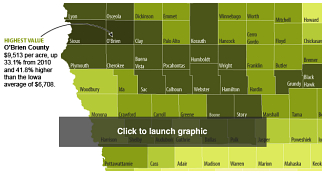
By Tim Jones and Elizabeth Campbell
Pickup trucks lined a stretch of gravel road where 150 farmers mingled between 7-foot tall cornstalks and shimmering soybeans to see which of their wealthy brethren would bid on a swath of Iowa’s richest cropland. This was a farm — table-flat and 314 acres — so coveted that it drew three times the usual land-sale crowd.
“They ain’t making any more of this, boys,” auctioneer Rich Vander Werff barked into a microphone, his voice slicing through the rising July heat. “This is about as good as it gets.”
Thirty minutes later the bidding stopped at $14,300 an acre, more than four times the average for U.S. cropland. That meant about $4.5 million for the Schoenemans, a pioneering Iowa family that owned the property for generations.
Farmland auctions in Iowa now resemble a dressed-down spectator sport with Sotheby’s prices, a reflection of the yawning divide that has opened in some of the most bountiful stretches of rural America. Farm earnings in the state and throughout the U.S. increased at eight times the rate of nonfarm wages from 2008 to 2011, fueling resentment and straining the social fabric of places with deep egalitarian roots.

